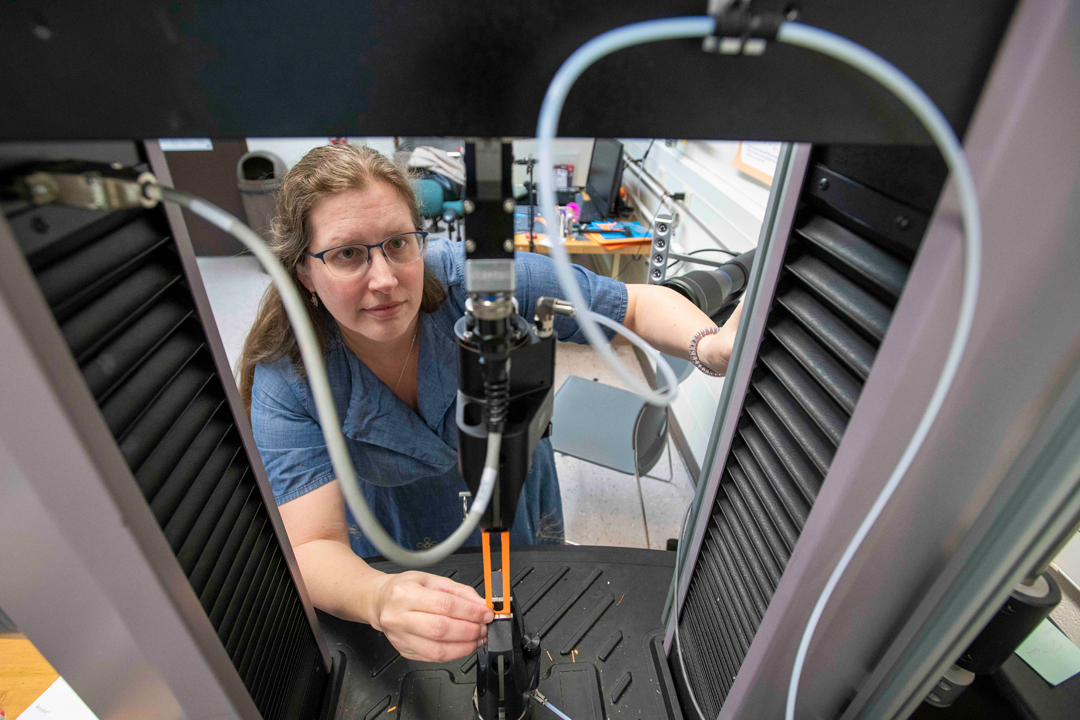Amy Engelbrecht-Wiggans recognized with 2024 National Science Foundation CAREER Award
Mechanical engineering researcher explores composite material performance before it begins to break down
Carlos Ortiz/RIT
Amy Engelbrecht-Wiggans, RIT’s newest NSF CAREER Awardee, explores how stress and strain on composite fiber bundles effects the materials to discover the crucial point before it begins to deteriorate.
Even Kevlar has a breaking point.
Fibers used to make the protective vests used by law enforcement and military personnel do have a shelf life. A researcher at Rochester Institute of Technology is exploring ways to improve their durability by isolating when material failures begin.
By exploring the point at which fiber composite materials begin to deteriorate and how the environment affects material, Amy Engelbrecht-Wiggans, an RIT assistant professor of mechanical engineering, believes there is a way to ensure longer-term reliability.
“Part of what really fascinates me is understanding what is going on as the material is breaking,” said Engelbrecht-Wiggans, who leads the Fiber Composite Reliability Lab in RIT’s Kate Gleason College of Engineering. “What is happening? How is it breaking? What happens as one of the fibers breaks, how does that influence the rest of the fibers in the material?”
To answer these questions, Engelbrecht-Wiggans received a National Science Foundation Faculty Career Development Award (CAREER) for “Understanding Fiber Bundle Failure Mechanics for Ultra-high Reliability Applications.” She’ll use computer modeling to investigate how fiber bundles behave, allowing for better estimation of bundle failure probabilities. Knowing failure probability allows for better decision making and potentially decreased costs for structures made from fiber bundles.
Composite fibers are familiar materials—reinforced plastics or polymers, such as fiberglass—and are often used as alternatives for heavier metals. If combined or layered, they result in stronger structured materials, such as those found in body armor, bridge cables, aerospace, and automotive applications. Increased tensile strength and lighter weight can lower production and usage costs.
Environmental conditions and load pressure make a difference in how the materials perform but also impact how long they will last and be effective.
“We are looking at how properties change over time. If we use these materials, and successfully make products lighter with composites—are they still safe? Anytime we are making composites, if we can make them lighter and still have confidence that they are going to hold, then that is very important because we can reduce the amount of material. This has many advantages for cost, fuel, sustainability, and safety improvements,” she said.
Broad objectives of this project are to understand how interactions between fibers determine the bundle stress-strain response through deformation to fracture and the key driving mechanics leading to bundle failure. Bundle failure is caused by instability leading to collapse, and understanding the onset of instability and the lower range of failure distribution is critical to ensuring reliability. Providing the ability to numerically predict distributions of bundle load-strain characteristics for fibers will result in a better understanding of the mechanics of fiber load sharing.
The award and research expertise builds on her early career work with NASA and the National Institute of Standards and Testing, as well as an interest Engelbrecht-Wiggans has in the art of knitting. Not unlike fibers used in knitting, some bundles of fibers used in composites are also called yarns.
She invited students to become a part of her research lab by asking if they liked to break things.
“I like to say that I make things with fibers for fun, and I break things with fibers for work,” she joked. “That is the niche I play in, the applications where we really do not want failure. We are just trying to make sure the material will not break and understand what is going on to ensure that long term, higher reliability. That is the research aspect.”
RIT has more than a dozen NSF CAREER award winners at the university. CAREER Awards are just one of several indicators of a university’s growing research initiatives, funding sources, and faculty innovation. The NSF receives thousands of proposals yearly, and only a fraction of awards are funded.













